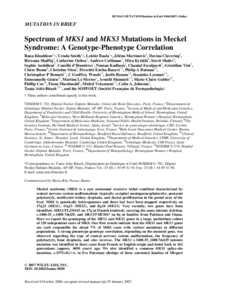Document
Spectrum of MKS1 and MKS3 mutations in Meckel syndrome : a genotype-phenotype correlation. mutation in brief #960. online.
Identifier
DOI: 10.1002/humu.9489
Source
Human mutation. V. 28, 5, P. 523-524.
Contributors
Smith, Ursula., Author
Baala, Lekbir., Author
Martinovic, Jéléna., Author
Clavering, Davina., Author
Shaffiq, Rizwana., Author
Ozilou, Catherine., Author
Cullinane, Andrew., Author
Kyttälä, Mira., Author
Shalev, Stavit., Author
Audollent, Sophie., Author
d’Humières, Camille., Author
Kadhom, Noman., Author
Esculpavit, Chantal., Author
Viot, Géraldine., Author
Boone, Claire., Author
Oien, Christine., Author
Encha-Razavi, Férechté., Author
Batman, Philip A., Author
Bennett, Christopher P., Author
Woods, C. Geoffrey., Author
Roume, Joelle., Author
Lyonnet, Stanislas., Author
Génin, Emmanuelle., Author
Le Merrer, Martine., Author
Munnich, Arnold., Author
Gubler, Marie-Claire., Author
Cox, Phillip., Author
Macdonald, Fiona., Author
Vekemans, Michel., Author
Johnson, Colin A., Author
Attié-Bitach, Tania., Author
Country
United States.
City
Hoboken
Publisher
Wiley-Liss, Inc.
Gregorian
2007-05-01
Language
English
Subject
English abstract
Meckel syndrome (MKS) is a rare autosomal recessive lethal condition characterized by central nervous system malformations (typically occipital meningoencephalocele), postaxial polydactyly, multicystic kidney dysplasia, and ductal proliferation in the portal area of the liver. MKS is genetically heterogeneous and three loci have been mapped respectively on 17q23 (MKS1), 11q13 (MKS2), and 8q24 (MKS3). Very recently, two genes have been identified: MKS1/FLJ20345 on 17q in Finnish kindreds, carrying the same intronic deletion, c.1408-35_c.1408-7del29, and MKS3/TMEM67 on 8q in families from Pakistan and Oman. Here we report the genotyping of the MKS1 and MKS3 genes in a large, multiethnic cohort of 120 independent cases of MKS. Our first results indicate that the MKS1 and MKS3 genes are each responsible for about 7% of MKS cases with various mutations in different populations. A strong phenotype-genotype correlation, depending on the mutated gene, was observed regarding the type of central nervous system malformation, the frequency of polydactyly, bone dysplasia, and situs inversus. The MKS1 c.1408-35_1408-7del29 intronic mutation was identified in three cases from French or English origin and dated back to 162 generations (approx. 4050 years) ago. We also identified a common MKS3 splice-site mutation, c.1575+1G>A, in five Pakistani sibships of three unrelated families of Mirpuri origin, with an estimated age-of-mutation of 5 generations (125 years).
Description
Volume 28, Issue 5, Pages 523-524
ISSN
1098-1004
Category
Journal articles

